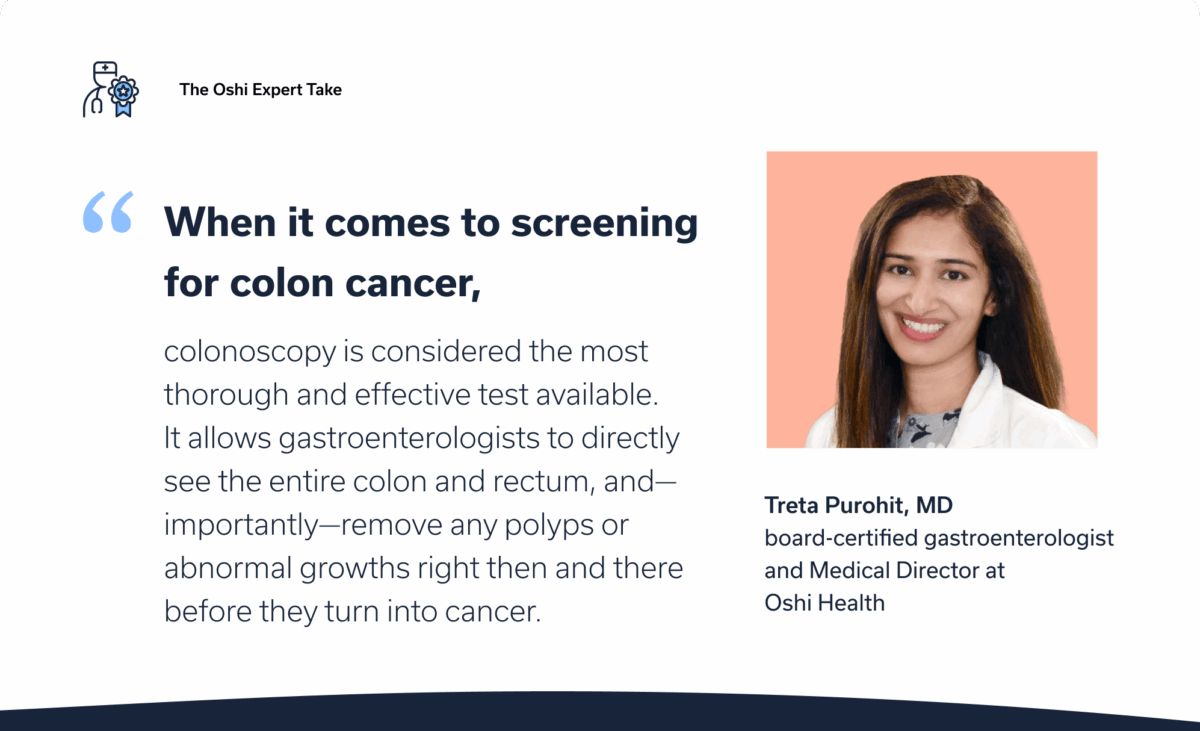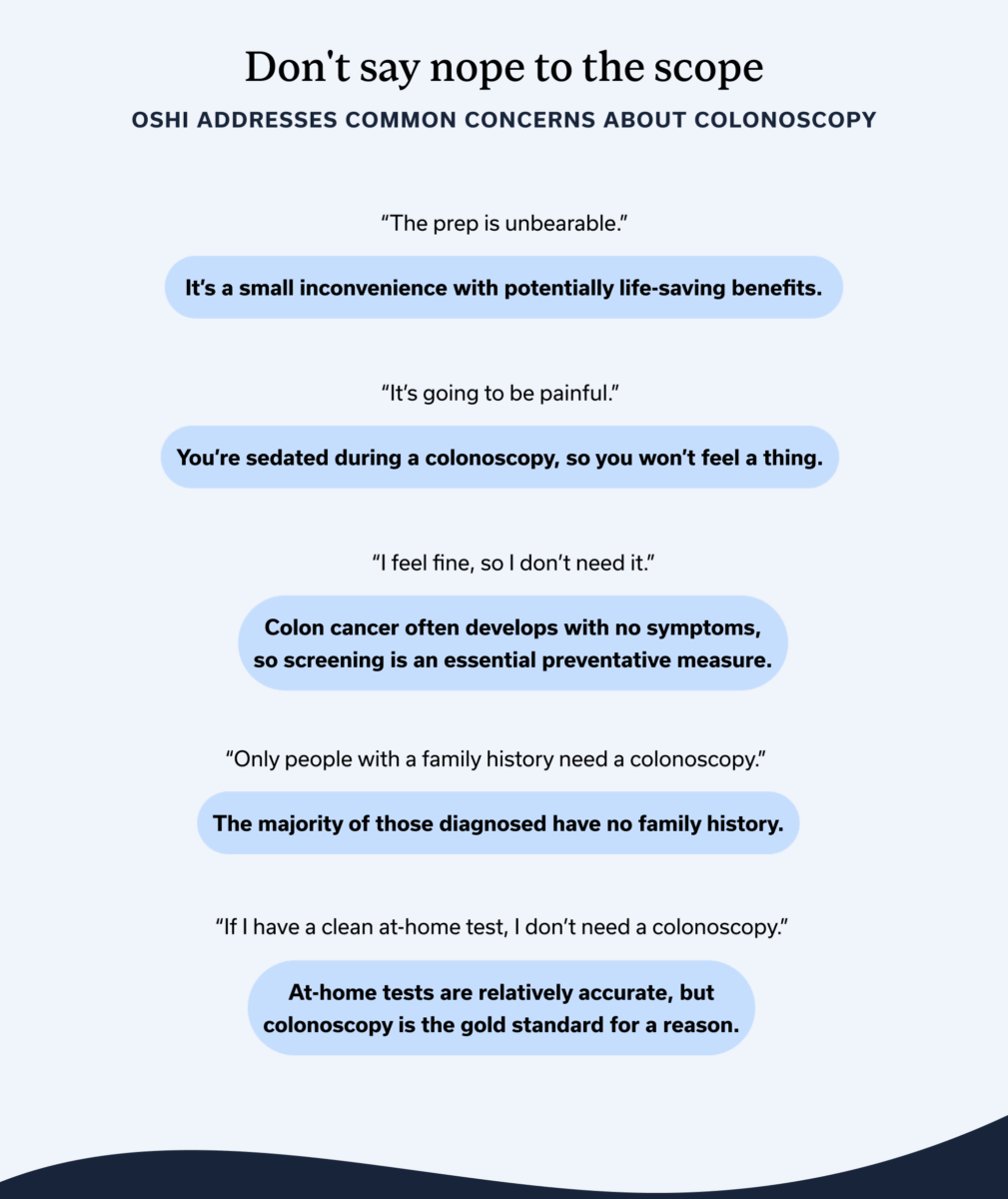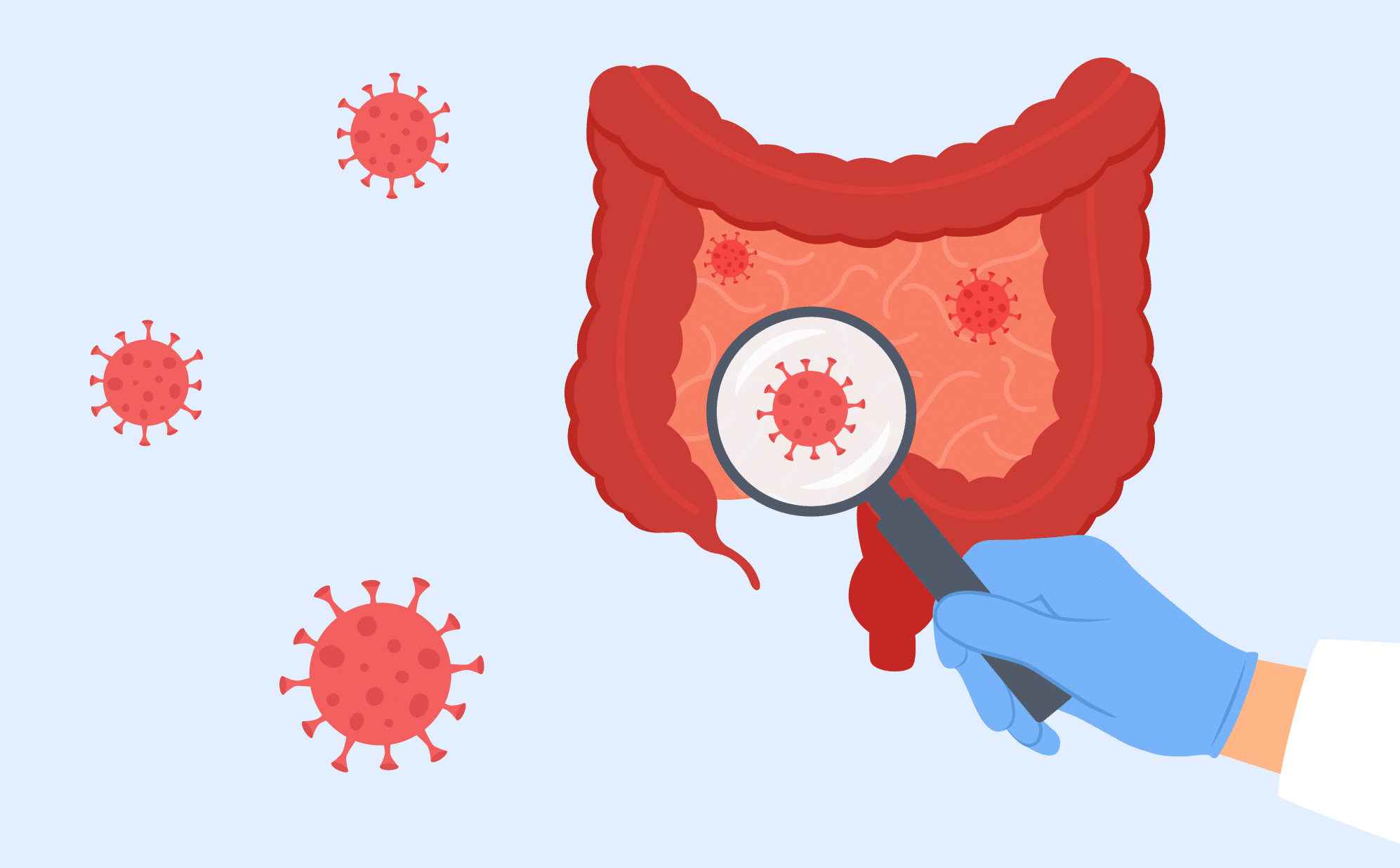A colonoscopy is a recommended screening for all individuals ages 45 to 75 years old and one that patients with certain gastrointestinal conditions may need earlier or more frequently. Recently, at-home colon tests have started cropping up, inspiring people to consider them as an alternative to a traditional colonoscopy. But while at-home colon cancer tests are relatively accurate and convenient, they aren’t a colonoscopy replacement. Here’s why.
We’ve all procrastinated at some point, whether putting off making dinner or scrolling social media instead of diving head-on into a work project. When it comes to colon cancer screening, however, procrastination is your worst enemy. Prompt use of at-home tests and colonoscopies can spot colon cancer early, providing time to treat an otherwise symptomless type of cancer.
Colon cancer screenings are recommended for individuals between the ages of 45-75, as well as those who fall outside this age range but have additional risk factors (i.e. having inflammatory bowel disease, a history of colon cancer, certain polyps, or previous radiation in the pelvic area or abdomen). People who are not at an elevated risk for colon cancer should get a colonoscopy every 10 years. At-home colon cancer tests as a supplementary option are recommended every one to three years.
But when exactly should you use an at-home colon cancer screening, and when will you definitely want to go the colonoscopy route instead? We’ll dive into this and more key questions ahead. First, some background on both screening approaches: What’s the difference?
What is a colonoscopy?
A colonoscopy is the traditional and most-used approach to colon cancer screening—and it’s the gold standard for many reasons, including efficacy, accuracy, and the way it sets you up for quick and accessible follow-up care with your GI provider. A colonoscopy is a 30-60 minute procedure where your provider, usually a gastroenterologist, inserts a thin tube with a camera into your rectum and colon. The provider will look for any abnormalities, including colorectal polyps. They’ll then either take a sample to be read in a lab, or even remove the polyp(s) during the colonoscopy.
What are at-home colon cancer tests?
“An at-home colon cancer test is a non-invasive screening tool that allows patients to collect a stool sample at home and send it to a lab to be analyzed for signs of colorectal cancer or advanced polyps,” says Treta Purohit, MD, board-certified gastroenterologist and Medical Director at Oshi Health. The two most common types of at-home tests are a fecal immunochemical test, FIT for short, and multitarget stool DNA tests, aka Cologuard. Both are FDA-approved and relatively effective, though how they work differs:
- FIT: This at-home stool test assesses whether there’s blood in your stool, an early sign of cancer. To complete this test, you’ll collect your own stool sample and send it to a lab for analysis.
- Cologuard: While similar to FIT, cologuard analyzes both the DNA and blood in a stool sample.

Both test types are relatively accurate. FIT accurately identifies 79% of cases where colon cancer is present and 94% of cases where colon cancer isn’t. Cologuard offers a higher accuracy rate for identifying colon cancer (92.3%, to be exact). However, it can only identify 86.6% of cases where colon cancer isn’t present, leading to more false positives.
Understanding the pros and cons of at-home colon cancer tests
It’s always a good idea to look at the pros and cons before making a medical decision. At-home colon tests definitely have both. The pros include:
- Accessibility: “While colonoscopy is considered the gold standard due to its diagnostic and therapeutic capabilities, at-home tests offer a more accessible, lower-barrier option for patients who may be hesitant or unable to undergo colonoscopy,” says Dr. Purohit.
- Convenience and Privacy: Some folks appreciate the convenience and privacy of completing this screening at-home instead of in a hospital or outpatient center.
- Less invasive: These tests don’t require sedation and are less invasive than a colonoscopy.
- No bowel prep: A colonoscopy often requires bowel prep the night before. With an at-home test, you get to skip this step.
That said, at-home tests have some cons as well:
- Cannot detect all polyps: Polyp is the medical term for an abnormal cell growth that may turn into cancer. At-home tests can’t detect smaller polyps, including some precancerous lesions.
- Cannot remove polyps: Your healthcare provider can remove polyps during a colonoscopy; this is naturally not an option while you’re testing at home.
- False negatives: At-home tests have a high accuracy rate, but that rate isn’t 100%. A false negative could hinder diagnosis, leading to late detection of colon cancer.
- False positives: A false positive often means scheduling a colonoscopy and waiting with unwarranted anxiety and stress.
- May still have to get a colonoscopy: Even if you go to the trouble of sourcing and completing an at-home test, you may still have to schedule a colonoscopy. That’s because if a DIY test delivers abnormal results, the next step is to schedule a colonoscopy for a more accurate screening (and to remove any polyps).
When to consider an at-home test
There are three main scenarios when you may want to consider doing an at-home colon test. The first is: If you are someone with an average risk of colon cancer and have been putting off getting your colonoscopy.
“If you’re healthy and don’t have any contraindications, colonoscopy is the most accurate and comprehensive option. It allows us to directly look at the entire colon, find and remove polyps during the same procedure, and catch early signs of cancer that other tests might miss. It’s the gold standard for a reason,” explains Dr. Purohit, “That said, at-home stool tests—like FIT or stool DNA tests—can be a great alternative for people at average risk who prefer something non-invasive or who aren’t ready for a colonoscopy. They’re easy to do, done in the privacy of your home, and can help get more people screened who might otherwise put it off.”
The second scenario in which you might opt for an at-home test is if you have a preexisting condition that makes it difficult to undergo a colonoscopy. This can include:
- An inability to be sedated
- Hemodynamic instability
- Peritonitis
- Recent bowel injury and repair
- Recent myocardial infarction
- Recent surgery with colonic anastomosis
Finally, some may view at-home tests as a supplementary screening between regular colonoscopies. For reference, colonoscopies are recommended every ten years for those with average risk, but at-home tests can be taken in between if you’re wanting to remain on top of testing.
And if you’re wondering where to get a colon cancer test kit, your preferred in-person or online pharmacy should carry them. Most of these tests are available without a prescription, though it is a good idea to consult a GI provider about which test might best suit your needs, and to help with test interpretation and follow-up care.
What to do if your at-home test is positive
You can think of an at-home test like a dress rehearsal; it provides a relatively solid idea of colon health but lacks a key audience (i.e. a gastroenterologist). When a FIT test is positive, schedule an appointment with a gastroenterologist as soon as possible. The gastroenterologist will discuss any factors, like food or medications, that may impact results, and provide clarity on what the results mean. They may also schedule a colonoscopy if recommended. A 2022 study suggests someone with a positive FIT test is twice as likely to die if they don’t get a subsequent colonoscopy.
When there’s a positive cologuard test, a gastroenterologist will schedule a colonscopy for further evaluation.
Technically, the recommended time frame to schedule a colonoscopy is up to three months after a positive at-home result. But this isn’t a permission slip to procrastinate; those who schedule a colonoscopy within one month of a positive test result often have more time to prep for any necessary treatment or surgery, and may receive more prompt referrals.
Why a colonoscopy is still the gold standard
“When it comes to screening for colon cancer, colonoscopy is considered the most thorough and effective test available,” says Dr. Purohit. “It allows gastroenterologists to directly see the entire colon and rectum, and—importantly—remove any polyps or abnormal growths right then and there before they turn into cancer.”

Admittedly, a colonoscopy is more invasive than at-home tests, but having an experienced GI specialist conduct your screening can provide peace of mind. It’s helpful to know that any samples are being collected and interpreted by a professional who can quickly connect you to next steps or even immediately remove polyps while you’re there.
Addressing common concerns about colonoscopy
There’s no denying the colonoscopy procedure gets some complaints, both due to the bowel prep involved and the procedure itself. While the idea of a camera inserted in your intestine can (understandably) seem uncomfortable, know that a colonoscopy isn’t as bad as it might seem.
Dr. Purohit dispels the five colonoscopy myths she hears often—and offers the truth behind each.
- “The prep is unbearable.” In the days leading up to a colonoscopy, you’ll probably have to follow a special diet to get rid of any stool (i.e. you’ll need to eat a lot of fiber). You’ll also have to clean out your bowels the night before or the morning of your procedure, which often involves laxatives. While this prep isn’t fun, it’s less intensive than it used to be—and it’s a small inconvenience compared to the potentially life-saving benefits of a colonoscopy.
- “It’s going to be painful.” Since you’re sedated during a colonoscopy, you won’t remember much about the procedure, and you certainly won’t feel it. Dr. Purohit adds that many patients say the worst part is worrying beforehand.
- “I feel fine, so I don’t need it.” “Colon cancer often develops with no symptoms in its early stage,” explains. Dr. Purohit. “That’s why regular screening is so important—it helps us catch and remove polyps before they turn into cancer.”
- “Only people with a family history need a colonoscopy.” While a family history increases the risk of colon cancer, the majority of those diagnosed have no family history.
- “If I have a clean at-home test, I don’t need a colonoscopy.” While relatively accurate, these tests are not perfect. There’s also a chance of a false positive or negative.

Making the best choice for your health
Ultimately, the decision is in your hands, though discussing your options with a GI provider will get you a valuable expert opinion to aid in your decision-making. When comparing the two options, remember that colonoscopy is the only test that can both detect and prevent cancer. That makes it the best choice, especially for those with a higher risk level. Factors that can increase your risk include:
- Personal history of colon cancer or certain polyps
- Inflammatory bowel disease (both Crohn’s disease and ulcerative colitis)
- History of radiation in pelvic area or abdomen for treating another type of cancer
“Colonoscopy has a much higher chance of finding early-stage cancers and precancerous polyps compared to at-home tests,” says Dr. Purohit. “For example, studies show that it finds nearly twice as many advanced growths as stool tests… And since it’s both a screening and treatment tool in one, colonoscopy can actually prevent colon cancer from developing in the first place. Because of this, major medical groups like the American College of Gastroenterology recommend colonoscopy as the most effective way to screen for colon cancer and reduce the risk of dying from it.”
Final takeaways
The best test is the one that gets done. But, while a home screening is better than no screening at all, a colonoscopy is the gold standard for a reason: it’s effective, administered by an expert GI provider, and it best sets you up for success in terms of accuracy and speedy access to follow-up care . When deciding on the best option for you, keep in mind:
- At-home tests are clinically validated, convenient options: These tests boast a decent accuracy rate. They’re convenient, non-invasive, and easy to complete.
- But a colonoscopy is the go-to standard: A colonoscopy is better at detecting polyps than non-invasive tests. Colonoscopies are recommended for all Americans between the ages of 45-75 and those with a higher risk level outside this age bracket.
- A GI provider can help make the right choice: At the end of the day, the best test is the one tailored to your comfort and risk levels. A GI provider can walk you through different options and help you choose the right one for you.
Oshi Health has a team of GI providers who can consult on different colon screening options and any other gastrointestinal concerns using a whole-person approach. You don’t have to make this decision alone; consult an Oshi GI provider today.
Frequently asked questions (FAQs)
-
Thanks to at-home colon cancer kits, you can screen for colon cancer at home. The two most popular types of at-home colon cancer tests are the FIT and cologuard tests. Both require you to collect a stool sample and send it to a lab for analysis. Still, a colonoscopy administered by a clinician remains the most effective and reliable screening method.
-
Home colon cancer tests are relatively accurate, identifying positive cases correctly in 79-92.3% of cases and negative cases correctly in 86.6-94% of cases. This does, however, leave room for false positives and negatives, which is why a colonoscopy is still the most effective testing option.
-
While free at-home tests aren’t available for everyone, many private insurance providers and Medicare plans cover the costs for qualified individuals. Additionally, nonprofits like the American Cancer Society sometimes run drives to provide free tests to those who cannot afford them.
-
A digital rectal exam, often referred to as a finger test, is when a doctor inserts a gloved, lubricated finger into the rectum, feeling for any abnormalities. This test isn’t a substitute for a colonoscopy and is often part of an annual physical examination for those between the ages of 45-75 or at a higher risk level.
-
At-home colon cancer tests usually cost less than $100, though costs vary depending on the manufacturer and an individual’s insurance coverage. Many private insurance plans and Medicare cover the cost of at-home tests—and private insurance companies, as well as Medicare, cover the cost of colonoscopy without cost share for individuals who qualify.
Oshi is your partner in digestive health
Feel like your digestive concerns are running your life? You’re not alone—and we’re here to help you find lasting relief.
Oshi Health GI providers, gut-brain specialists, and registered dietitians work together to address the root cause of your symptoms and find solutions that actually work for you.
Whether you’re dealing with chronic digestive issues or unpredictable symptom flare-ups, our GI specialists deliver:
✔ Personalized care plans tailored to your lifestyle
✔ Science-backed strategies to calm your gut
✔ Compassionate, whole-person care
✔ And so much more!
Ready to take control of your gut health?






